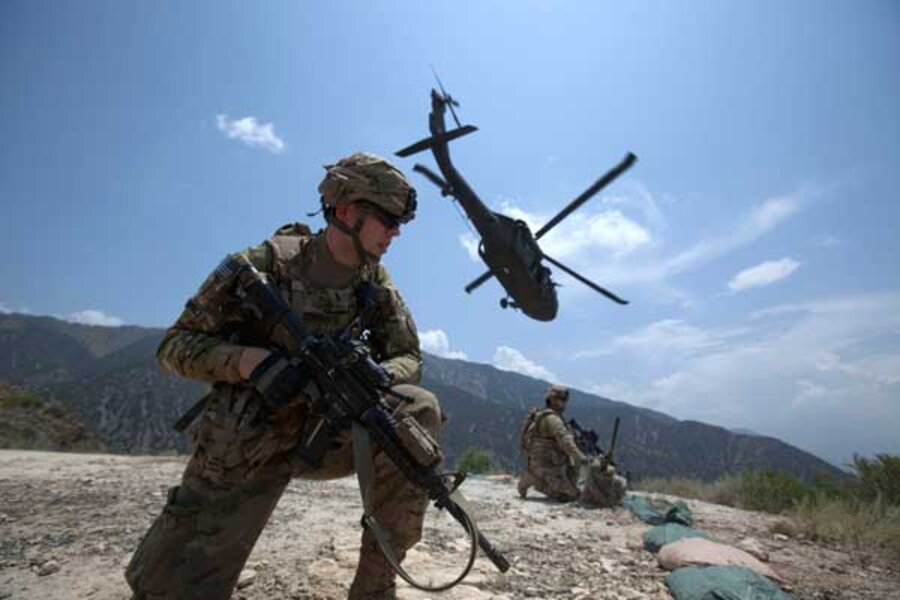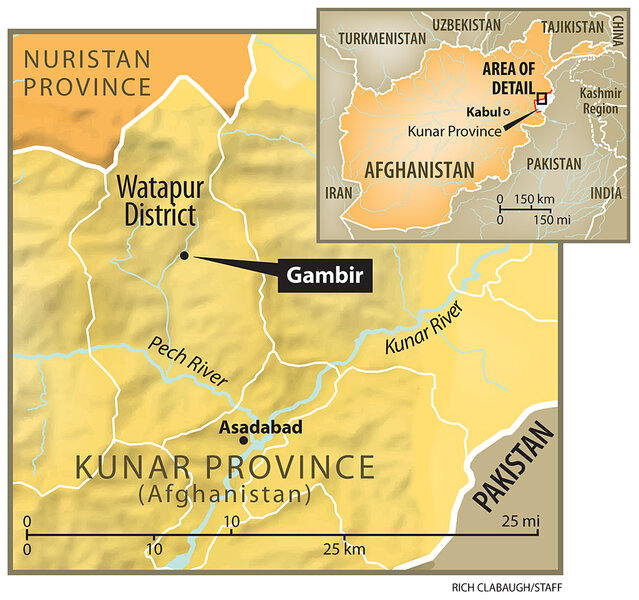Battle for Afghanistan's Gambir Jungle: What was it all for?
Loading...
| Kunar, Afghanistan
[To read the previous installment of this series, please click here.]
Down in the Gambir Jungle on the morning of Monday, June 27, the stricken 1st Platoon at last had the relief it had needed for two days. But as the sun rose on the ridgeline more than 3,000 feet above the 1st, Havoc Company was facing a new onslaught.
The Taliban came at Havoc like "a bunch of guys coming to a street fight – with a whole bunch of different types of weapons," says Pfc. John Litwinczuk.
Then the rounds started hitting. "Our sandbags got shot up, a round hit a rock right in front of my face," he adds.
The insurgent forces – a mix of foreign and local fighters – continued to advance to the point that Litwinczuk could hear them change their rifle magazines or moan when they were shot. "That was one thing I remember," he says.
The US commanders on the ground were worried.
"By the second day, I was asking [troops], 'Can you hold your line?' " says Havoc Company commander Capt. Christopher Bluhm, who has served two previous deployments. "I was concerned that [the insurgents] were going to push through."
As June 27 wore on, though, something else became obvious on the ridgeline where Havoc sat: The Americans were weathering the storm.
The same was true for 1st Platoon down in the mud-walled kulats of the Gambir Jungle. US sharpshooters began to get their bearings, picking out targets. "Then they were losing guys and not us anymore," says Lovelace of the 1st.
With the arrival of the 3rd Platoon in Gambir on June 27, the battle-weary 1st Platoon was at last set to leave.
Nightfall again brought a freedom that day did not, and platoon members worked their way to the landing zone where they would be picked up, grasping at tree roots along the way to keep from sliding down the steep face of loose dirt and gravel.
Two days later, at nightfall on June 29, commanders told Havoc Company troops to break down their fighting positions. They had held the line and could now return to base.
The soldiers slashed sandbags with their knives so insurgents couldn't make use of them and kicked away stone walls they had built.
In the rain, they began to descend to the landing zone, tripping and falling down a steep descent through thick underbrush. They waited for evacuation until, as the rain increased, they got the news: The exfiltration had been called off because of the weather. They would not be departing that night.
Commanders, concerned about leaving troops vulnerable on fishbowl-shaped low ground, ordered them back up the hill to cobble together the fighting positions they had just destroyed. "We were crawling on all fours," says Litwinczuk.
At 3 a.m., Havoc Company troops started rebuilding, piecing together the shredded sandbags. "We were furious – at least that's what was driving me," Litwinczuk adds. "That night felt the coldest to me."
Some 24 hours later, soldiers made the same trip to a landing site, finally boarding helicopters that would take them back to their base.
The battle's tally
In the weeks after Operation Hammer Down, a commander's assessment rendered a bulleted verdict:
- Approximately 124 enemies killed in action and 51 wounded.
- Enemy operations in the Pech and Watapur valleys disrupted.
- Foreign-fighter training camps reduced.
- Enemy lines of communication severely disrupted.
In the end, a fresh unit that had been flown in pushed into the Gambir training camps. Senior US military officials say the battle made a considerable difference.
"They were able to not just make a statement, but I think the effect of that has tremendously affected the whole entire district of Watapur," says Col. Richard Kim, commander of the 3rd Brigade, 25th Infantry Division, which included the troops in Operation Hammer Down.
But sitting in an isolated outpost in the Pech River Valley, soldiers from B Company's 1st and 3rd Platoons wrestle with the losses of the mission – and question what they accomplished in seven days of hard fighting.
"Our whole objective was to clear out a training camp," says Sgt. Paul Robertson of the 1st Platoon.
"And we failed," interjects a soldier, who had been standing nearby, listening to the others tell the story.
"I think we inadvertently did clear that camp out," says another with soldierly humor. "It was like, 'Training camp dismissed, guys – sink or swim.' "
For Sgt. Ridge Kaaekuahiwi of the 1st Platoon, the frustration comes from a fear that the dynamic did not change – that it was all for nothing.
"When you really get down to it, we're not winning any fight," he says. "We're just fighting fighters."
One month after the mission, an intelligence report on the Gambir Jungle indicated "increased Al Qaeda and Pakistani presence" in area training camps – "an effort," it noted, "to resupply after Operation Hammer Down."
The battle for the Gambir Jungle:
Part 1, Tuesday: Soldiers' tales of an epic battle
Part 2, Wednesday: Into the 'Valley of Death'
Part 3, Thursday: First Platoon's 'last stand'
Part 4, Friday: A race against daybreak
Part 5, Saturday: What was it all for?






